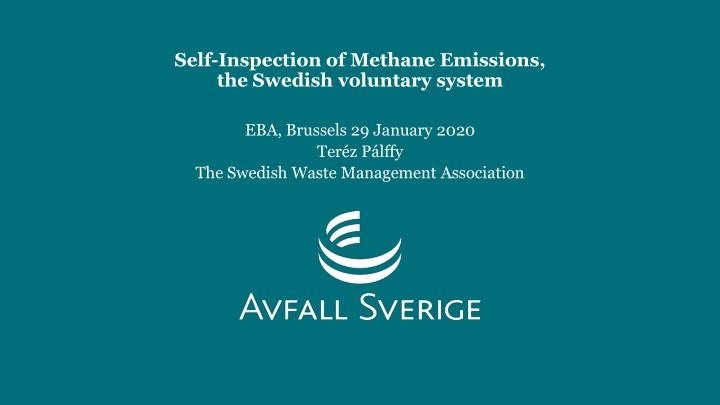



Self-Inspection of Methane Emissions, the Swedish voluntary system EBA, Brussels 29 January 2020 Teréz Pálffy The Swedish Waste Management Association
I will talk about … ▪ Short background on biogas in Sweden The Swedish Voluntary System ▪ ▪ Results
The Swedish Waste Management Association ▪ The municipalities' organisation for waste management and recycling ▪ About 400 members ▪ 19 employees (17 in Malmö, 2 in Stockholm) Main activities ▪ Disseminating knowledge o Promoting the exchange of experience o Influencing decision makers o Information activities and development projects o ▪ Our vision is "Zero Waste"
Biogasproduction in Sweden Co-digestion plants 36 (963 GWh) Wastewater treatment plants 138 (727 GWh) Farm plants 44 (56 GWh) Industrial plants 6 (143 GWh) Land fil 55 (141 GWh) Producing in total ≈2 TWh biogas Upgrading plants 70 plants in total Co-digestion plants Wastewater treatment plants Upgrading plant Source: Energigas Sverige
How the biogas is being used Upgrading – that is transport Heat Electricity Industry Other Flaring Missing data Source: ER 2019:23 Production and use of biogas and biofertiliser 2018
Substrate for biogas production (kilo tonnes wet weight) 2018 Food Sewage Industry Manure Waste from Slaughter Crops Other waste sludge sludge food industry houses Wastewater treatment Co-digestion plants Farm plants Industry Gasification Source: ER 2019:23 Production and use of biogas and biofertiliser 2018
Background to ” EgMet ” Self-Inspection of Methane Emissions - Voluntary system Started in 2007 Co-digestion plants 2/3 and ¾ upgrading plants and <10 wastewater treatment plants participated Reasons to participate Environment and climate Economy Safety aspects and work environment Odour problems Credibility Photo: Tore Sigurdsson
Main targets • further improve the environmental performance of the biogas system give plant owners help in performing a structured • inventorying of their plant to detect emissions • give plant owners better knowledge about the size of the emissions from their plant • identify and reduce any emissions • give the biogas industry better information and thereby greater credibility in relation to emissions.
Organisation Biogas industry Project execution team Reference team Steering comittee Joint administrative office The Swedish Water and Wastewater Association EgMet 2.0 The Swedish Waste Management Association
Participation/System set-up • Participation • Annual fee • Skills develoment Photo: Teréz Pálffy
EgMet consists of two main parts 1) Systematic leak detection and avert found leaks 2) Emission measurement at emission points with suggestions for reduction • Regular and systematic leak detection and a more extensive leak detection once a year (inhouse) • Quantafiying emissions every three years (executed by external and independent part) Report includes quantification records and deviation reports for • each spoted emission point and provides suggestions for reducing emissions. • The quantifications are then sent to the administrative office by the plant
System boundaries at co-digestion plants
Potential emission objects and remedying emissions
System boundaries for a wastewater treatment plants
System boundary at an upgrading plant
Results Four three-year period since 2007; 2007-2009, 2010-2012, 2013-2015 and 2016-2019 • Authorities Sustainability reports • • Benchmarking Photo: Teréz Pálffy • Further development of the system Method development • • Project support such as EvEmBi and MetHarmo
Biogas production the years 2013-2015
Upgrading plants the years 2013-2015
Biogas production over the three periods
Thank you for your attention! TACK Teréz Pálffy 0046 70-428 12 40, terez.palffy@avfallsverige.se www.avfallsverige.se
Recommend
More recommend